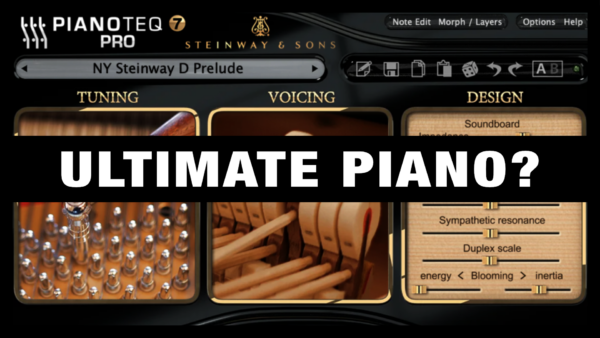 Are you looking for the Ultimate Piano VST Plugin for Your Music?
Are you looking for the Ultimate Piano VST Plugin for Your Music?
Perhaps you want a dreamy cinematic piano, or a soft romantic piano, or a bright pop piano, or a creepy dissonant piano…
In fact, you can get every single piano sound you can imagine with this incredible piano plugin.
Why? Well, because this is not a traditional sample library of a recorded piano. It is based on physical modeling, and it is called Pianoteq.
NOTE: This review is on the latest version Pianoteq Pro 7.
The Power of Physical Modeling
Every single aspect of a piano has been modeled with advanced algorithms. From the strings to the hammers. From the acoustics to the sympathetic resonance.
And you can really feel the end result, which has an incredible attention to the details, and creates a wonderfully dynamic, deep and authentic sound.
What you get with Pianoteq 7
There are several different packages (versions) of Pianoteq 7 that you can choose between: Pianoteq Stage, Pianoteq Standard and Pianoteq Pro. They have some small differences in the options you get in the engine, but more importantly, they include a different amount of instrument packs.
Because with Pianoteq you can actually access a huge range of other instrument packs, like electric pianos, chromatic percussion etc. Check out this full list of instrument packs: Pianoteq Instrument Packs.
However, just the acoustic piano pack on its own is huge. You get a range of grand pianos with lots of variations, as well as upright and pop/rock pianos, and even historical pianos. And with all the presets, and incredible sound shaping capabilities you get on each instrument, you can pretty much create any tone and mood you want for your piano sound.
Interface and Features
The interface is very simple and straightforward, and gives you access to all important aspects to change the sound. You can then click on each of these modules to dive deeper and start experimenting with specific parameters. Here are the main interface modules:
Tuning
You can set the overall tuning frequency, as well as temperament. Default is the standard 440Hz with equal temperament. But you can even go in and change the tuning each note, and also set advanced parameters for the tuning.
Voicing
This is where you set the overall tone with hammer hardness for different dynamics (piano, mezzo and forte), as well as a the density for the harmonic overtones to 8 degrees. You can also adjust hammer noise etc.
Design
Here you practically design the “virtual piano”, with string length, soundboard parameters, sympathetic resonance etc.
Velocity
Set the response curve for dynamics in regards to velocity (how hard you hit the keys) from ppp to fff. You can even do a calibration of your own MIDI keyboard to set a perfect velocity curve for the MIDI keyboard response and playing style you have. If you switch this view you can also calibrate your sustain pedal and aftertouch.
Output
Choose the final output to be stereo, mono, binaural etc. And the magic starts when you go in and change microphones, adjust the position and perspective, set different outputs per microphone etc.
Action
Here you can adjust damper position, sustain pedal noise level, key release noise etc. But there are also parameters for mallet bounce, equalizer, and an entire FX section with delay, reverb, EQs, tremolo, chorus etc.
Advanced Features
Pianoteq 7 also has some very cool advanced features that I really enjoy. Here are the best ones in my opinion:
Layering
You can layer 2 or more sounds, and set different levels for each layer. When you are in the “layers” mode you can even click the random button which creates a new mix of layers by randomly selecting a sound preset for each layer.
Morphing
Now morphing might look like “layering”, but it is not a simple cross-fade of two audio sources like you usually get with layers. No, morphing is way more advanced, as you actually create a brand new instrument by fusing the morphing layers into one single coherent instrument. You can also mix the morph layers depth on the final output. And even add more “ingredients” as they call the different instruments you use for morphing.
Randomize
You can start with any instrument preset, and then click the small dice button, which will randomize all parameters of the sound…and in doing so you actually create a totally new and unique instrument. Incredibly fun to use, especially in combination with the morphing/layering modes.
My Final Thoughts
I have so many piano sample libraries and VST plugins, but Pianoteq is something unique. It is not simply a collection of samples. It is an entire instrument with incredible depth and features, where you can create and shape the perfect piano sound for any music production you work on.
Now another bonus you get from physical modeling is that the plugin itself takes up so little hard drive space on your computer, and a tiny RAM footprint in your DAW.

